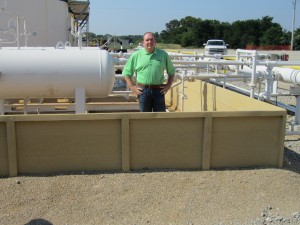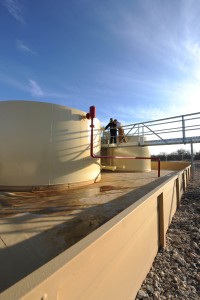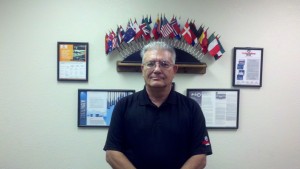In the Permian Basin, accepting and mastering corrosion brings cost 
containment and peace of mind.
Remember the television commercials for Fram oil filters that made the phrase “Pay me now or pay me later” a recognized part of American culture?
Well, those involved in the corrosion control end of the oil and gas industry could use the same slogan today. Operators can pay for corrosion control up front, or they can pay for the subsequent remediation and maintenance costs when corrosion results in a spill or causes a mechanical breakdown, according to Larry Perkins, director of research and development for Falcon Technologies, one of a number of companies in the Permian Basin that specialize in various methods of corrosion control and prevention.
 Perkins was one of the founders of Falcon Technologies when it first started in Midland. Although the company is now headquartered in Southlake, it still has facilities in Midland; Decatur; Shreveport, La.; and Horsehead, N.Y. In fact, Falcon Technologies has recently moved into a new, larger location in Midland at 9115 West Country Road 127 to be able to serve additional customers.
Perkins was one of the founders of Falcon Technologies when it first started in Midland. Although the company is now headquartered in Southlake, it still has facilities in Midland; Decatur; Shreveport, La.; and Horsehead, N.Y. In fact, Falcon Technologies has recently moved into a new, larger location in Midland at 9115 West Country Road 127 to be able to serve additional customers.
“We are also establishing an operation in Colorado to serve the Niobrara [play],” Perkins added. He said that every basin in the country has its own unique corrosive issues, including high production temperatures. In the Permian Basin, however, the potential problems are carbon dioxide (CO2) and toxic hydrogen sulfide (H2S).
Falcon Technologies’ slogan is “Engineering to protect your investment, the environment, and your reputation.” He says the company’s patented Falcon Liner provides spray-on polymer protection that is impervious to corrosion or damage due to chemicals or weather, virtually eliminating the risk of leaks. With a useful life of 20-plus years, it dramatically reduces maintenance and replacement costs, according to Perkins.
“We started in May 2003,” he said of Falcon Technologies. “I started in the  construction business and did remediation work. But I decided I was on the wrong side of the business. It was time to be proactive instead of reactive. When I was doing remediation work after a spill, they were happy to see me come, but they didn’t like the bill.”
construction business and did remediation work. But I decided I was on the wrong side of the business. It was time to be proactive instead of reactive. When I was doing remediation work after a spill, they were happy to see me come, but they didn’t like the bill.”
Then in early 2004, Perkins claimed he started looking at different polyurethanes, researching products from seven or eight different manufacturers. Polyurethane, of course, is made of highly elastic organic polymers, or chains of molecules that are primarily composed of carbon and hydrogen derived from fossil fuels. A polyurethane coating forms a durable surface with an impermeable seal from the environment, protecting the substrate from physical damage or corrosion caused by oxidation or humidity. It can be used to coat and protect many materials, including wood, metal, and plastic.
“The problem was not with the polyurethanes, but how they were marketed,” Perkins explained. “We evolved formulations for each purpose. There are a lot of issues with each purpose, and everything is give and take. One product may have higher corrosive resistance, but it might be more brittle and subject to stress fractures.”
He said Falcon developed products that were not only corrosion resistant but could also perform well.
“For example, if we coat a tank, it can be repurposed, reused, and transported without breaking the liner,” Perkins said.
Secondary containment
While applications of the Falcon Liner include tank liners, tank bases, location liners, and water impoundment, Perkins claimed the largest percentage of the company’s business in the Permian Basin is secondary containment systems. Falcon has received patents in 2009 and 2011 on its containment system, which goes through a professional engineers’ certification that it will contain 100 percent of a potential spill. Perkins said Falcon does computer modeling and physical testing, as well as building full-scale prototypes, to ensure its accuracy.
That can be critical, claimed Perkins, who recalled a secondary containment system that Falcon built several years ago for a customer at a large facility in the Permian Basin.
“We finished it on a Saturday,” he recalled. “They turned the equipment back online, but when they went back out there on Monday, they discovered something had failed and they had 1,000 barrels of crude oil spilled. Our system contained all of it and we were able to recover all of the oil with no impact to the environment. We have never had a catastrophic failure.”
Tank bases
Falcon Technologies also provides the Falcon Liner tank base that provides a simple solution to corrosion that comes from moisture as the tank sits on the ground. It eliminates the need for difficult and high-maintenance pea gravel installations as the base for the tank. Instead, the tank sits on the Falcon Liner base, which prevent exterior corrosion from moisture from the bottom.
“If a spill occurs, you can steam-clean the base or dispose of it,” Perkins added. “It is hard to remediate pea gravel. Our tank bases are faster to install at the same cost as pea gravel. It is a better product at the same price.”
Epoxy coating
CeRam-Kote Coatings, Inc., provides a high-performance industrial epoxy coating for many uses, including military aircraft, the shipping industry, and dry docks, as well as offshore platforms operating domestically or internationally. It also has a coating for concrete floors. But much of its work is done in the oil and gas industry, coating pipes, tanks, vessels, and anything else that needs abrasion and corrosion resistance, according to Jack Richardson, CeRam-Kote’s vice president of sales.
He said the company has a strong distribution network worldwide, with a presence in Singapore, Beijing, and Europe, as well as branch offices throughout the United States. But everything is manufactured and shipped from its facility in the Industrial Airpark in Big Spring.
In fact, CeRam-Kote just moved into a new state-of-the-art facility adjacent to its existing 40,000-square-foot facility at the old Air Force base in Big Spring. Richardson said CeRam-Kote currently coats nearly 7,000 feet of Oil Country Tubular Goods a day, but he expected that number to double when the company’s new facility came on line in late May.
“We are not in the pipe business, we are in the coating business,” he emphasized. Although CeRam-Kote, which currently has 32 employees at its Big Spring facility, can coat either the inside or outside (or both) of the pipe, Richardson estimated 95 percent of the company’s work is coating the inside diameter of the pipe. The slick epoxy, or plastic, coating is only about 10-millimeters thick, Richardson added, meaning it is a coating, not a lining.
CeRam-Kote’s coating is important in protecting the pipe from abrasion and corrosion, especially the corrosion that comes from CO2 or H2S in the Permian Basin. Richardson said the company recently did a big job for the George R. Brown Company for a CO2 flood project it has in the Basin, but he added that CO2 can occur naturally and cause corrosion in the normal primary production of crude oil or natural gas.
“We also did a big coating job for Chesapeake Energy recently for its horizontal drilling operation in Arkansas [in the Fayetteville Shale play],” he added.
Richardson estimated that CeRam-Kote has coated nearly 20 million feet of pipe since it opened its facility in Big Spring in 1985.
Fiberglass liners
Midland-based Composite Lining System offers two different products for use in saltwater disposal wells, water injection wells, CO2 injection wells, producing wells in CO2 floods, and many other producing wells in which the fiberglass liner is important to protect the steel pipe from corrosion.
“We install our GlassBore liner in customer-owned tubing,” explained Joe Schwalbach, president of Composite Lining System. “Our GlassLine tubing is a finished product, where the lining has already been installed in the pipe.”
Schwalbach said customers can usually get a better price by purchasing their own pipe and then having his company install the tubing. But if they are in a bind, Composite Lining System can provide the finished product with the GlassLine tubing immediately.
The increase in activity in the Permian Basin means extended time to have the liners installed, although he offered that the sweet crude produced in the enormous Wolfberry play hasn’t impacted his business much. But Kinder Morgan’s new CO2 injection program in the Katz Field in Stonewall County as well as its continued expansion of the giant SACROC Unit in Scurry County, along with the Oxy’s CO2 enhanced oil recovery work near Denver City, has Composite Lining System “blowing and going,” according to Schwalbach.
“It may be overshadowed by the Wolfberry play, but companies are still going back and expanding with tertiary recovery,” he added. “If you don’t have corrosive protection, you can have failure at the well head, which means down time and increased costs.
Self-containment system from Falcon Technologies.










